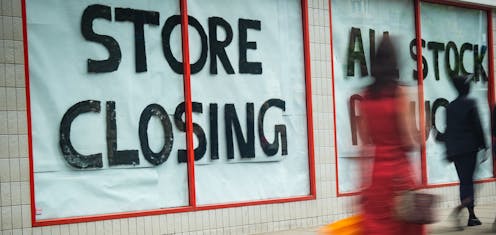
This article is part of The Conversation’s “Business Basics” series where we ask experts to discuss key concepts in business, economics and finance.
Today’s economic data shows that, outside of the pandemic, the Australian economy has slowed down to its lowest annual rate of growth since the early-1990s recession.
That’s prompting the dreaded question: are we headed for another one?
Any mention of the “R” word can trigger anxiety. Recessions bring job losses and financial strain, and put serious pressure on people’s mental health.
These impacts can be especially severe for people who are already experiencing disadvantage and vulnerabilities.
But what exactly does it mean to be in a recession? What are the different ways we define them? And are these current approaches the best way to measure people’s economic pain?
Read more: This is the weakest economy outside of a recession. Here's what the GDP figures show
What’s a recession?
A bit like the waves of the ocean, our economy is characterised by ebbs and flows in overall activity.
Spending and business growth can swell during times of confidence, but slow down when optimism deflates or the economy is hit by an unexpected shock such as a pandemic or climate disaster. This pattern is what economists describe as “the business cycle”.
Most of the time, our economy is constantly growing, even if the pace varies.
Conventionally, we measure this pace by tracking changes in the level of gross domestic product (GDP) – the overall volume of items and services being produced, bought and sold in the economy.
The latest economic growth rates of 0.2% for the June quarter, and 1% over the past year, tell us that the Australian economy is still growing, even if at a slower pace than previous years.
Occasionally, the economy slows down to such a grind that economic activity, from one quarter to the next, shrinks. When this happens, the GDP measurements come out negative.
When we have two negative measurements of GDP in a row, this is defined as a technical recession.
This is what happened to most countries around the globe during the COVID-19 pandemic. Prior to the pandemic, Australia hadn’t experienced a technical recession since 1991.
The latest figures tell us Australia is staying afloat for now. But that doesn’t mean it doesn’t feel like a recession to many people. Some other metrics show why.
Other measures of recession
Growth in economic activity is fuelled, in part, by a growing population. Dividing total economic output by the population size, GDP per capita can offer a more accurate picture of people’s economic reality.
This population-adjusted measure of economic growth has long fallen into negative territory. Today’s figures tell us that Australia’s GDP per person has been shrinking for 18 months. Our annual per capita growth rate is now -1.5%.

In the United States, recessions are measured differently again. Recessions are officially declared by the National Bureau of Economic Research (NBER). Unlike technical recessions, these aren’t based on a simple rule.
NBER considers a range of measures beyond GDP – including personal income, employment, personal consumption, wholesale and retail sales, and industrial production across multiple sectors – when deciding whether to declare a US recession.
Is Australia heading for a recession?
This is a challenging question to answer because the GDP figures economists conventionally use to diagnose the situation only come to light after a recession hits.
Today’s economic figures from the ABS are for the June 2024 quarter – now more than two months old. Measurements of the current economic climate won’t come through in official statistics for some time.
If it occurs, by the time a recession is officially diagnosed, we’re usually well and truly in it.
A similar limitation applies to the retrospective approach of the NBER, which “waits until it is confident that a recession has occurred”.
It’s like a weather forecaster declaring a cyclone has hit only after the wind gusts have blown your roof away.
But we can use other metrics to alert ourselves to recession risks before the eye of the storm hits.
Using jobs numbers as a recession alert
One approach is the Sahm Rule, named after its creator, US economist Claudia Sahm.
By analysing patterns in the monthly unemployment data that preceded past recessions, Sahm devised a formula to detect when increases in the current unemployment rate were rapid enough to pose a recession risk.
The advantage of this approach is that unemployment statistics come out more quickly and frequently than GDP numbers.
Many would also argue that monitoring unemployment, rather than GDP, is a more meaningful metric to reflect people’s everyday experiences of the economy and wellbeing.
The Sahm approach tracks how quickly the national unemployment rate is currently rising compared to the past year.
It’s calculated by comparing the current three-month moving average of the national unemployment rate to this figure’s lowest value in the previous 12 months. This “moving average” approach smooths out the bumpiness of monthly figures.
A jump of 0.5% or more signals the economy’s current pattern is on the cusp of recession.
While the Sahm formula was developed for the US economy, it does a fairly good job of waving a red flag where recessions previously occurred in the Australian economy, too.
Australia’s latest unemployment rate – inching up to 4.2% in July 2024 – pushed the Sahm value up to 0.5%.
This indicator doesn’t necessarily mean that a recession will occur. But it suggests policymakers should be on high alert.
The Sahm indicator also validates the experiences of job seekers who – despite official definitions that the economy is not in recession – are personally feeling the pressures of a slowing economy and shrinking job opportunities.
As our approaches to measuring and managing the ups and downs of the economy continue to evolve, these people-centred metrics are an increasingly important part of our toolkit.
Leonora Risse receives research funding from the Trawalla Foundation and the Women's Leadership Institute Australia. She is a member of the Economic Society of Australia and the Women's in Economics Network. She serves as an Expert Panel Member on gender pay equity for the Fair Work Commission.
This article was originally published on The Conversation. Read the original article.







